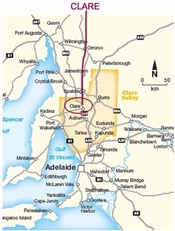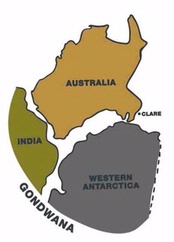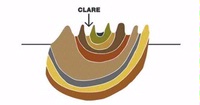|
|
 |

When geologists study winegrowing areas, part of the fun of exploration is figuring out the earthly influences that make the area especially hospitable to wine grapes. More than just the study of rocks and their derivative soils, we consider the forces of nature that combined to create the topography we observe. Piecing together the complex puzzle of factors that result in distinctive vineyard sites allows us to understand the entirety of the place -- the terroir, if you will. In the broadest sense, the geologic underpinnings of any specific place, vineyard or otherwise, affects the character of that site.
One of the many geologically intriguing wine regions is the Clare Valley of South Australia. Vines were first planted here by Silesian Jesuit priests fleeing religious persecution in Europe. The Sevenhill Winery in the eponymous town was founded by the freedom-seeking Jesuits over 150 years ago. Although the Clare Valley accounts for less than five percent of Australia’s wine production, much of it is of high enough quality to attract attention from the world’s wine buyers.

Kangaroo Amidst the Clare Valley Vines
The Clare has long had a distinction of producing stellar examples of very different wine types. Most famous is perhaps the Clare Valley Rieslings -- pure, vibrant, high acid, clean and dry Rieslings with lovely lime blossom and lime zest aromas and flavors. We also find Clare Valley Shiraz wines that are impressive in their power and depth of blackcurrant and blackberry fruit. Of course, there are other grape varieties grown here that comprise a range of offerings. How is it, though, that a narrow valley with relatively arid climate can yield such different and expressive wines in close juxtaposition? It’s like having a Côte Rôtie grown next to Muscadet.

The Clare Valley Location
Although--at first glance--the Clare might seem too hot a site for fine wine production, there are a number of ameliorating factors that work in its favor. It has some moderating influence from oceanic breezes, but its altitude of 1200 – 1500 feet allows significant nighttime cooling -- the diurnal shift needed for quality wine grapes. Plus, its dry climate affords protection from mold and mildew problems that beset vineyards in other areas.
Fortunately for the wine and rock aficionados of the world, the Clare Valley grape growers association provides a great deal of information about the geologic underpinnings of the valley, giving us clues regarding the reasons for its diverse viticultural successes. Those interested should check out the clarevalleyrocks.com.au website.
The Clare Valley has a long geologic history, with the origin of its rocks stretching back some 800 million years. The geologic cross section of the modern Clare Valley shows a range of hills and valleys that set the stage for modern viticulture. The sediments that comprise the rocks we observe today were laid down beginning some 800 million years ago when quiet waters dominated the environment. The deposits were thousands of feet thick, with varying amounts of clay, silt and sand. The earth had a very different appearance at that time, with the precursors of Australia, Antarctica, and India clustered together as the Gondwana supercontinent.

The Australia of 800 Million Years Ago
While the geologic story is long and complex, we can compress it into a few stages. After the basin sediments were buried, compacted and lithified, the scene changed rather dramatically. A massive uplift around 500 million years ago created a high mountain range, likely as tall as the Himalayas are today, and contorted the rocks into a folded sequence that became the basics of the structure we see today. Erosion during the intervening eras has reduced the mountains to the modern configuration, with the more durable quartzites and sandstones forming ridges and softer rocks and younger alluvial sediments evident in the valleys.

The Geology of the Clare Valley Region Today
The complex underlying geology has created a wide range of soil types in the Clare Valley, but two in particular seem especially beneficial to Riesling grapes. There is the “terra rossa” soil in the southern part of the valley -- a red loamy surface soil underlain by white limestone that yields more forward and ripe Rieslings in the area around Auburn. In the Polish Hill River area of the northern Clare, the soils are underlain by a combination of shale and slate that has not only been quarried as building stone, but also underpins the somewhat austere and long-lived style of Rieslings drawn from vineyards in the region.
The wide-ranging alluvial sediments in the northern part of the valley have proven more conducive to red wine production. While Shiraz accounts for approximately thirty percent of Clare grape production, Cabernet Sauvignon comprises nearly half as much, and there are significant plantings of Merlot, Grenache and Malbec as well. The tradition of blending Cabernet with Malbec is a long-standing one and yields some excellent, richly textured blends.
The Clare Valley does not have the large production facilities we find in the Barossa. It is a region of relatively small estates. Thus, the quantities of specific wines can be limited. There are, however, many examples of Clare wines available in the US market if you seek them out. The next time you savor the purity of a Clare Valley Riesling, or the power of a Clare Shiraz, or the supple texture of a Cabernet – Malbec, you can enjoy it all the more knowing that it comes from such a distinctive and special place.
|
 |
|